• Title: The Fermi Bubbles as Starburst Wind Termination Shocks
• Author: Brian C. Lacki
• Author’s Institution: Jansky Fellow at the Institute for Advanced Study at Princeton
The Background
In keeping with the recent theme of posts, let’s talk some more today about some of the crazy things going on in the center of our very own Milky Way! Yesterday Anna posted about the gas cloud expected to stir up some action this fall in the Galactic center … but what about the action that’s already there?
One of the Galactic center’s most interesting recently-discovered features — and currently a very hot topic, if the most recent meeting of the High Energy Astrophysics Division of the AAS is any indication — are the huge inflated lobes of gamma-ray and radio emission extending above and below the Galactic disk. We’ve discussed these structures, called the Fermi Bubbles, before in this post by Alice back in January; I’ve included the artist’s impression of the bubbles from her post because I think it gives a great sense of the scale involved.
As Alice explains in her post, there are two main theories for how these bubbles were formed: 1) It has something to do with activity from the supermassive black hole at the center of the Galaxy, or 2) it’s somehow related to the active star-forming region in the Galactic center.
Well, add one more vote to the star-formation theory, because today’s paper argues that the Fermi Bubbles are in fact the termination shocks of the wind produced by star formation in the center of the Galaxy.
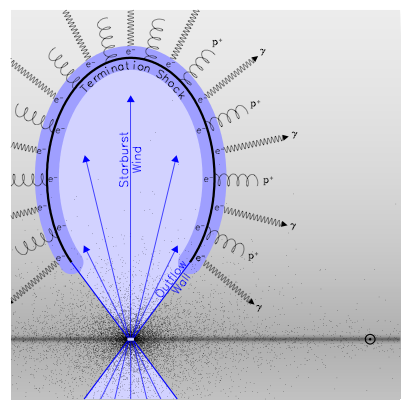
Sketch of the CMZ and its termination shock with respect to the Galaxy. The horizontal line shows the galactic disk, with the circle marking the location of the Sun. Figure 1 in the paper.
The Theory
In the center of our Galaxy lies a region called the Central Molecular Zone (CMZ). This region is filled with gas and is forming stars at a rate of about 0.1 M☉ yr-1 — enough to qualify it as a starburst region (a region with an abnormally high star formation rate), but relatively modest when compared to very active star-forming regions we observe in places such as M82, which clocks in at a rate 100 times higher. Thus the author suggests the CMZ might serve as somewhat of a prototype for starburst regions and outflows.
According to current models of of starburst regions, when the energetic supernova remnants in star-forming regions overlap, winds erupt, filling with plasma and propagating outward. These winds are sustained as long as the star formation continues. As the winds push forward and spread out, they slow down and become more diffuse, which causes the pressure within the wind to drop. When the pressure of the wind is equal to the pressure of the medium it’s expanding into, a termination shock forms.
A termination shock of a traditional starburst would not be a good explanation for the Fermi Bubbles, since the Bubbles are structures on a galactic scale (~10 kpc), whereas the termination shock for traditional starbursts lies far out beyond the galaxy in the intergalactic medium. But because the CMZ wind is less dense than typical starbursts’ winds, the wind pressure from the CMZ is much lower than usual — and as a result, the CMZ wind can be stopped by the Galactic halo instead of the intergalactic medium. The author argues that we are seeing exactly this when we look at the Fermi Bubbles.
Comparing to Observations
The author puts his model to the test by comparing it to a number of different observations of the Fermi Bubbles. First he shows that the radius of a bubble that could be inflated by the CMZ is comparable to the size of the Fermi Bubbles. He then demonstrates that the timescale that it would take for the CMZ to inflate the Bubbles (~10 Myr) is short enough to be consistent with what we see today. Finally, he discusses the source of the radiation that we observe from the Fermi Bubbles, demonstrating that the termination shock could accelerate cosmic rays up to enormous energies, and that these cosmic rays could produce gamma-ray radiation consistent with what we observe from the outer edges of the Bubbles.
Conclusion
In proper critical-scientist form, the author concludes with a discussion of possible problems with his model — as well as potential solutions. One of these problems is that we observe the Fermi Bubbles to be elongated, which isn’t consistent with a starburst model (which should blow spherical bubbles). The author suggests two potential reconciliations: perhaps the pressure in the Galactic halo depends on the distance from the midplane, or the CMZ outflow might have its power concentrated along a central conical axis. Another issue is that there have been recent observations of small protrusions within the Fermi Bubbles that look like they might be jets from Sgr A*. To explain these within the star-formation model, the author suggests that they might instead be stellar clusters within the CMZ, or smaller cluster winds.
So, are the Fermi Bubbles related to outflows from Sgr A*? Or are they coming from the star-forming region at the Galactic center? This paper adds an argument in favor of star-formation as the cause, but the issue remains a hot topic! I definitely recommend staying tuned as we inevitably learn more.


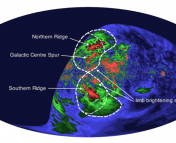
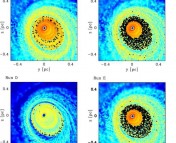
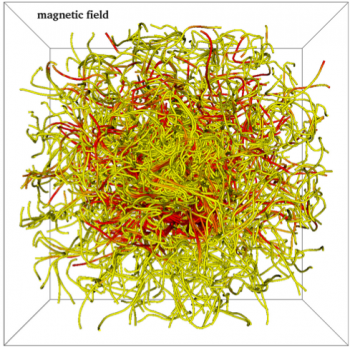
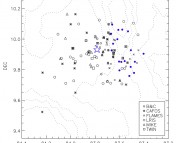
Trackbacks/Pingbacks